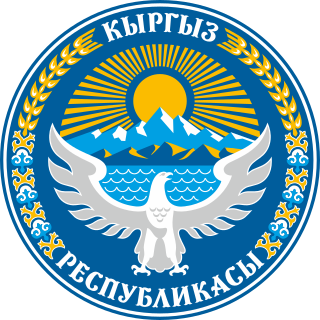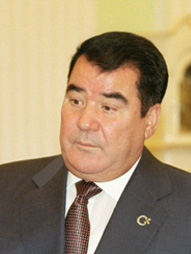 |
|---|
A referendum on extending President Saparmurat Niyazov's term until 2002 was held in Turkmenistan on 15 January 1994. [1] Official results showed that the proposal was approved by 99.99% of voters, with a 100% turnout. [1]
 |
|---|
A referendum on extending President Saparmurat Niyazov's term until 2002 was held in Turkmenistan on 15 January 1994. [1] Official results showed that the proposal was approved by 99.99% of voters, with a 100% turnout. [1]
In 1985, Saparmurat Niyazov, then the first secretary of the Ashgabat Communist Bloc, was handpicked by Soviet leader Mikhail Gorbachev into elite politics as a replacement for Muhammad Gapusov, the First Secretary of the Communist Party of Turkmenistan. [2] This replacement was part of the Central Asian purges in the wake of the Uzbek cotton corruption scandal. [2] In January 1990 Niyazov was elected to the Supreme Soviet of the Turkmen Soviet Socialist Republic and was appointed as its chairman. [1] [2] Two months later, Niyazov was elected by the Supreme Soviet to the new office of president. [1] Following in the footsteps of his predecessor(s), Niyazov prevented Gorbachev-era reforms from having any tangible effect on what was among the most conservative federal republics of USSR. [1] [2] Opposition groups were routinely disbanded and members exiled on charges of anti-Soviet activities. [2]
In October 1990 his presidency was "unanimously" confirmed by the masses. [1] A year later he led Turkmenistan to secede from the Soviet Union despite an initial reluctance, and decreed a new constitution that promulgated a presidential government. [2] [3] The political atmosphere of the newly independent state remained as conservative as before, with Niyazov finding "classic, democratic formulas [..] that worked out in some prosperous Western country" unsuitable for Turkmenistan. [2] In 1992 Niyazov was re-elected unopposed as president, receiving over 98% of the vote. [1] Following these victories, Niyazov went further in manifesting a totalitarian regime based on a cult of personality. [1] [2] [3]
Voters were asked to decide whether to prolong the term of President Niyazov by six years, until 2002. [1] The question was worded "Do you support extending the term of President Saparmurat Niyazov until 2002?"
According to official statistics, 100% of the registered voters (1,959,637) participated in the referendum. [1]
| Choice | Votes | % | |
|---|---|---|---|
| For | 1,959,408 | 99.99 | |
| Against | 212 | 0.01 | |
| Total | 1,959,620 | 100.00 | |
| Valid votes | 1,959,620 | 100.00 | |
| Invalid/blank votes | 17 | 0.00 | |
| Total votes | 1,959,637 | 100.00 | |
| Registered voters/turnout | 1,959,637 | 100.00 | |
| Source: Nohlen et al. [1] | |||
The promised elections were not held in 2002 as Niyazov had himself declared President for life by the Assembly on 28 December 1999. [1] He would rule until his death in 2006.

The history of the Kyrgyz people and the land now called Kyrgyzstan goes back more than 3,000 years. Although geographically isolated by its mountainous location, it had an important role as part of the historical Silk Road trade route. Turkic nomads, who trace their ancestry to many Turkic states such as the First and Second Turkic Khaganates, have inhabited the country throughout its history. In the 13th century, Kyrgyzstan was conquered by the Mongols; subsequently it regained independence but was invaded by Kalmyks, Manchus, and Uzbeks. In 1876, it became part of the Russian Empire, remaining in the USSR as the Kirghiz Soviet Socialist Republic after the Russian Revolution. Following Mikhael Gorbachev's democratic reforms in the USSR, in 1990 pro-independence candidate Askar Akayev was elected president of the SSR. On 31 August 1991, Kyrgyzstan declared independence from Moscow, and a democratic government was subsequently established.

The politics of Kyrgyzstan, officially known as the Kyrgyz Republic, takes place in the framework of a presidential system representative democratic republic, whereby the President is head of state and the Chairman of the Cabinet of Ministers is head of government. Executive power is exercised by the government. Legislative power is vested in both the government and parliament. The Economist Intelligence Unit rated Kyrgyzstan an "authoritarian regime" in 2022.

The history of Turkmenistan traditionally began with the arrival of Indo-European Iranian tribes around 2000 BC. Early tribes were nomadic or semi-nomadic due to the arid conditions of the region, preventing widespread adoption of agriculture. The steppe culture in Central Asia was an extension of a larger Eurasian series of horse cultures which spanned the entire spectrum of language families, including the Indo-Europeans and Turko-Mongol groups. Some of the known early Iranian tribes included the Massagatae, the Scythians/Sakas, and early Soghdians, who were most likely precursors of the Khwarezmians. Turkmenistan was a passing point for numerous migrations and invasions by tribes, which gravitated towards the settled regions of the south, including ancient Mesopotamia, Elam, and the Indus Valley civilization.

The politics of Turkmenistan nominally takes place in the framework of a presidential republic, whereby the President of Turkmenistan is nominally both head of state and head of government. However, as of 21 January 2023 a "national leader" was appointed who chairs an independent People's Council (viz.) with authority to amend the constitution, and who exercises supreme political authority. No true opposition parties are allowed; every registered political party supports the third and current President Serdar Berdimuhamedow. The country is frequently described as a totalitarian state.

The Republic of Uzbekistan is a presidential constitutional republic, whereby the President of Uzbekistan is head of state. Executive power is exercised by the government and by the Prime Minister of Uzbekistan.

The Turkmen Soviet Socialist Republic, also known as Soviet Turkmenistan, the Turkmen SSR, Turkmenistan, or Turkmenia, was one of the constituent republics of the Soviet Union located in Central Asia existed as a republic from 1925 to 1991. Initially, on 7 August 1921, it was established as the Turkmen Oblast of the Turkestan ASSR before being made, on 13 May 1925, a separate republic of the USSR as the Turkmen SSR.

The president of the Soviet Union, officially the president of the Union of Soviet Socialist Republics, abbreviated as president of the USSR, was the head of state of the Union of Soviet Socialist Republics from 15 March 1990 to 25 December 1991.

The Democratic Party of Turkmenistan is a political party in Turkmenistan founded in 1991. It has been the ruling party of the country since its foundation.

Turkmenistan elects on national level a head of state — the president — and a legislature. The elections in Turkmenistan since its split from the Soviet Union have been widely criticized for being neither free nor fair and attempting to give an appearance of legitimacy to what is in reality a dictatorship. Parties in Turkmenistan are the Democratic Party of Turkmenistan and the Party of Industrialists and Entrepreneurs. The president has a seven-year term, while the legislature has a five-year term.

Demokratizatsiya was a slogan introduced by Soviet Communist Party General Secretary Mikhail Gorbachev in January 1987 calling for the infusion of "democratic" elements into the Soviet Union's single-party government. Gorbachev's Demokratizatsiya meant the introduction of multi-candidate—though not multiparty—elections for local Communist Party (CPSU) officials and Soviets. In this way, he hoped to rejuvenate the party with progressive personnel who would carry out his institutional and policy reforms. The CPSU would retain sole custody of the ballot box.
A supreme leader or supreme ruler typically refers to the person among a number of leaders of a state, organization or other such group who has been given or is able to exercise the most – or complete – authority over it. In a religion, this role is usually satisfied by a person deemed to be the representative or manifestation of a deity or God on Earth. In politics, a supreme leader usually rules over an authoritarian or totalitarian government and has a cult of personality associated with them. Historic examples are Adolf Hitler of Nazi Germany, Francisco Franco of Francoist Spain, Benito Mussolini of Fascist Italy and Joseph Stalin of the Soviet Union.

Saparmurat Atayevich Niyazov, also known as Türkmenbaşy, was a Turkmen politician who ruled Turkmenistan from 1985 until his death in 2006. He was first secretary of the Turkmen Communist Party from 1985 until 1991 and supported the 1991 Soviet coup attempt. He continued to rule Turkmenistan for 15 years after independence from the Soviet Union in 1991.

The Congress of People's Deputies of the Soviet Union was the highest body of state authority of the Soviet Union from 1989 to 1991.

An independence referendum was held in the Armenia SSR on 21 September 1991 to determine whether to secede from the Soviet Union. It followed a declaration of independence on 23 August 1990. 99.5% of voters voted in favour, with a turnout of 95%. The country officially became an independent state on 23 September 1991.

An independence referendum was held in the Turkmen SSR on 26 October 1991.

Presidential elections were held in Turkmenistan on 21 June 1992, the first since independence. The sole candidate was Saparmurat Niyazov, who had served as the first Secretary of the Central Committee of the Communist Party of the Turkmen SSR since 21 December 1985. Other candidates were not allowed to participate in the elections.
Parliamentary elections were held in Turkmenistan on 11 December 1994, the first since independence. All 50 seats were won by the former Communist Party, which had rebranded as the Democratic Party of Turkmenistan and remained the sole legal party.
The following lists events that happened during 1991 in the Soviet Union and Russia.

The Union of Soviet Socialist Republics (USSR) was dissolved on 26 December 1991 by Declaration № 142-Н of the Soviet of the Republics of the Supreme Soviet of the Soviet Union, formally establishing the dissolution of the Soviet Union as a sovereign state and subject of international law. It also brought an end to the Soviet Union's federal government and General Secretary Mikhail Gorbachev's effort to reform the Soviet political and economic system in an attempt to stop a period of political stalemate and economic backslide. The Soviet Union had experienced internal stagnation and ethnic separatism. Although highly centralized until its final years, the country was made up of 15 top-level republics that served as homelands for different ethnicities. By late 1991, amid a catastrophic political crisis, with several republics already departing the Union and the waning of centralized power, the leaders of three of its founding members, the Russian, Belorussian, and Ukrainian SSRs, declared that the Soviet Union no longer existed. Eight more republics joined their declaration shortly thereafter. Gorbachev resigned on 25 December 1991 and what was left of the Soviet parliament voted to end itself.
Muza Alekseýewna Niýazowa is a Turkmen public figure who held the role of First Lady of Turkmenistan from 1991 until the death of her husband in 2006. She is the widow of the first president of Turkmenistan, Saparmurat Niyazov, with whom she had two children.